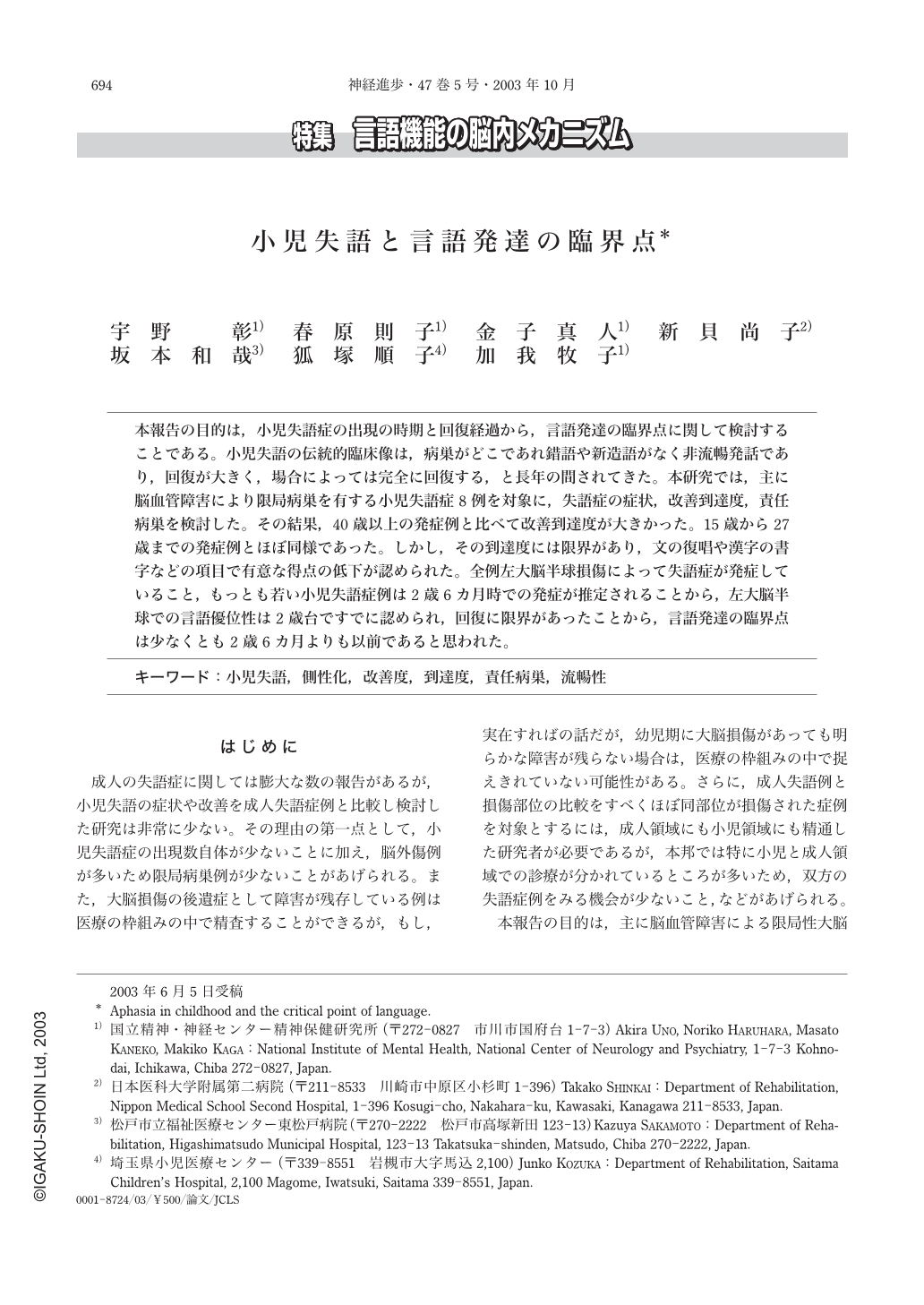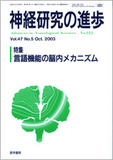Japanese
English
- 有料閲覧
- Abstract 文献概要
- 1ページ目 Look Inside
本報告の目的は,小児失語症の出現の時期と回復経過から,言語発達の臨界点に関して検討することである。小児失語の伝統的臨床像は,病巣がどこであれ錯語や新造語がなく非流暢発話であり,回復が大きく,場合によっては完全に回復する,と長年の間されてきた。本研究では,主に脳血管障害により限局病巣を有する小児失語症8例を対象に,失語症の症状,改善到達度,責任病巣を検討した。その結果,40歳以上の発症例と比べて改善到達度が大きかった。15歳から27歳までの発症例とほぼ同様であった。しかし,その到達度には限界があり,文の復唱や漢字の書字などの項目で有意な得点の低下が認められた。全例左大脳半球損傷によって失語症が発症していること,もっとも若い小児失語症例は2歳6カ月時での発症が推定されることから,左大脳半球での言語優位性は2歳台ですでに認められ,回復に限界があったことから,言語発達の臨界点は少なくとも2歳6カ月よりも以前であると思われた。
はじめに
成人の失語症に関しては膨大な数の報告があるが,小児失語の症状や改善を成人失語症例と比較し検討した研究は非常に少ない。その理由の第一点として,小児失語症の出現数自体が少ないことに加え,脳外傷例が多いため限局病巣例が少ないことがあげられる。また,大脳損傷の後遺症として障害が残存している例は医療の枠組みの中で精査することができるが,もし,実在すればの話だが,幼児期に大脳損傷があっても明らかな障害が残らない場合は,医療の枠組みの中で捉えきれていない可能性がある。さらに,成人失語例と損傷部位の比較をすべくほぼ同部位が損傷された症例を対象とするには,成人領域にも小児領域にも精通した研究者が必要であるが,本邦では特に小児と成人領域での診療が分かれているところが多いため,双方の失語症例をみる機会が少ないこと,などがあげられる。
本報告の目的は,主に脳血管障害による限局性大脳病変を有する小児失語症の経過から,小児の大脳の可塑性について検討することと,小児失語の発症時期と損傷部位から,言語機能の側性化とその時期について推定すること,および言語発達の臨界点について検討することである。
The purpose of this study is to investigate the critical point of language development from the viewpoint of the onset time and the recovery process of acquired childhood aphasia(ACA). The traditional clinical picture of ACA invariably claims nonfluency, and rapid and complete recovery. In our study, we investigated the symptoms, the recovery process and the lesion site in eight cases of ACA with localized lesions from cerebro-vascular disease mainly. As results, children with ACA showed higher recovery level than adult aphasics whose onset time was after 40 years of age, but their recovery level was almost the same as that of young aphasics whose onset time was between 15 and 27 year-old. Though the recovery level is high, the improvement was limited, and the scores of sentence repetition and Kanji writing were significantly lower than those of controls. As all children with ACA have lesions in the left hemisphere, and the earliest case of onset was presumed to be around two years of age, we suggest the possibility of the dominancy of the left hemisphere to be established in the second year after birth and the critical point of language development is assumed to be prior to the second year of age.

Copyright © 2003, Igaku-Shoin Ltd. All rights reserved.


